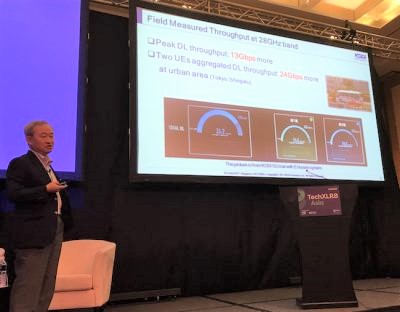
LIVE FROM 5G ASIA, SINGAPORE: Fumio Watanabe, chairman of KDDI Research (pictured), said obtaining a spectrum licence from the Japanese government is the biggest challenge to rolling out 5G in 2020.
He said the time schedule is very tight, with 3GPP specifications for the 3.7GHz, 4.5GHz and 28GHz bands due to be worked out by September 2018. As a result, the earliest KDDI can have a 5G licence is at the end of 2018, which would give it only a year to test.
“Hopefully we’ll have a 5G spectrum licence by end of 2018,” he said, noting the 3.7GHz, 4.5GHz and 28GHz bands are candidate frequencies being considered by the government.
He told Mobile World Live the 4.5GHz band is free in Japan, after operators gave up that frequency years ago, but it isn’t a global band, which he notes is a weak point. With with both the 3.7GHz and 28GHz bands, there is conflict with satellite operators, so there needs to be a new licensing policy. “It’s not easy to start to use these, even in Tokyo.”
The operator, Japan’s second largest with a 24 per cent market share, plans to launch commercial 5G services by 2020.
Japan currently has 700MHz of mobile spectrum available for mobile operators, Watanabe said. The Global mobile Suppliers Association (GSA) recommends 100MHz of 5G spectrum.
Watanabe noted propagation loss is increased at higher bandwidths, which limits coverage. KDDI plans to use a number of techniques to overcome some of the limitations.
Jake Saunders, VP for Asia Pacific at ABI Research, agreed operators need to explore other options, adding 5G will require more versatile cell site solutions including more small cells.
He noted trials in the 28GHz band have the largest share of the current round of tests around the world, followed by the 3.5GHz, and 3.6GHz to 6.8GHz bands.
